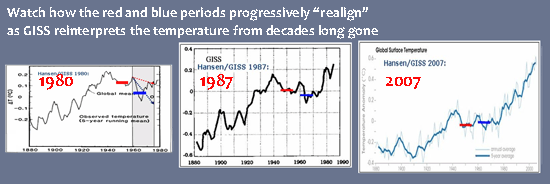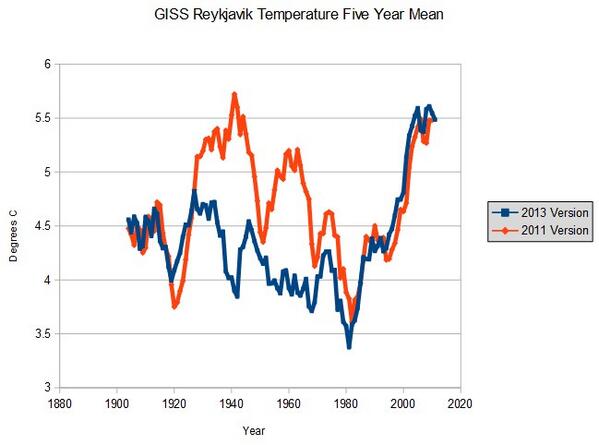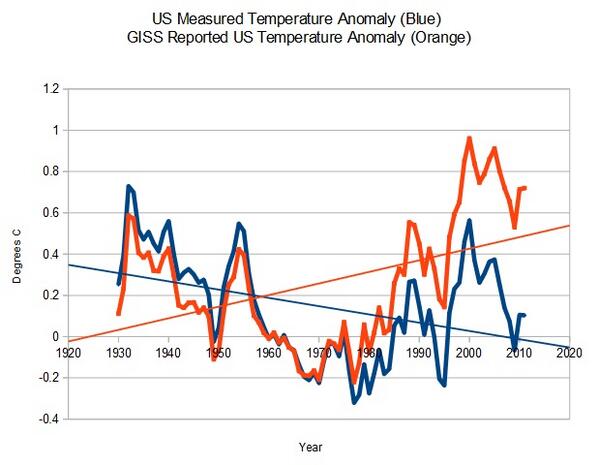According to the paper, "The Northern Territory of Australia has a unique situation of an extension larger than France and a population of 200,000, with only three meteorology stations open for more than 40 years, Darwin (DW), Alice Springs (AS) and Tennant Creek, and only two of them, [Darwin] DW and AS, providing data over 100 years, and from 500 to more than 1,000 km separating these stations and the stations in the neighbouring states of Australia.
This "smoking gun" of temperature data tampering in Darwin, Australia was pointed out over 4 years ago by Willis Eschenbach at WUWT, illustrated by Fig. 7 below showing a cooling trend of 0.7C per century in the raw data was up-justed to show a warming trend of 1.2C per century in the official data:
 |
| Figure 7. GHCN homogeneity adjustments to Darwin Airport combined record. Source |
As the author of the paper points out in the introduction below, "The science of climate change is characterized by selective filtering and sometimes manipulating the experimental evidence to compute rate of rise of temperatures or accelerations of sea levels much larger than what they actually are. While no particular local station records can necessarily be expected to conform to the global average pattern, the global average pattern is or should be built on the basis of the local results. If the IPCC global average temperature compilation incorporates some information from some of the local Australian records and this information is faulty in this regard, and the global average is suspect to the degree that it has been influenced by the use of the Australian records. While this paper is focused on the Northern Territory of Australia, similar arguments may certainly apply for other geographical areas worldwide further supporting the claim that the rate of rise of temperature and the acceleration of sea levels are presently overestimated."
Indeed, ample evidence exists that the global, US, Australian, New Zealand, Arctic and numerous other international temperature records have been tampered or "up-justed" to produce an artificial warming trend long after such records were collected.
 |
| NASA/GISS/Hansen global temperature data tampering |
 |
| Arctic data tampering |
 |
| US data tampering |
Theoretical and Applied Climatology
November 2013, Volume 114, Issue 3-4, pp 567-573
Alberto Boretti
The Northern Territory of Australia has a unique situation of an extension larger than France and a population of 200,000, with only three meteorology stations open for more than 40 years, Darwin (DW), Alice Springs (AS) and Tennant Creek, and only two of them, DW and AS, providing data over 100 years, and from 500 to more than 1,000 km separating these stations and the stations in the neighbouring states of Australia. Homogenizations of data in between different measuring sites for the same location as well as the way to derive the missed data to complete at least 100 years from the neighbouring locations are analysed in details and the effects on the temperature trends are straightforwardly investigated. Using properly homogenised data over 130 years and a linear fitting, the warming maximum and minimum temperatures are +0.009 and +0.057 °C/10 years for Alice Springs and −0.025 and 0.064 °C/10 years for Darwin. With the data available, the only option to produce warming trends is to overweight the cold years in the middle of the 1970s and the subsequent return to warmer temperatures. Starting from 1980, to compute trends, there is still a clear warming in Alice Springs, but also clear cooling in Tennant Creek, and a mixed behaviour with warming maximum temperatures and cooling minimum temperatures in Darwin.


No comments:
Post a Comment